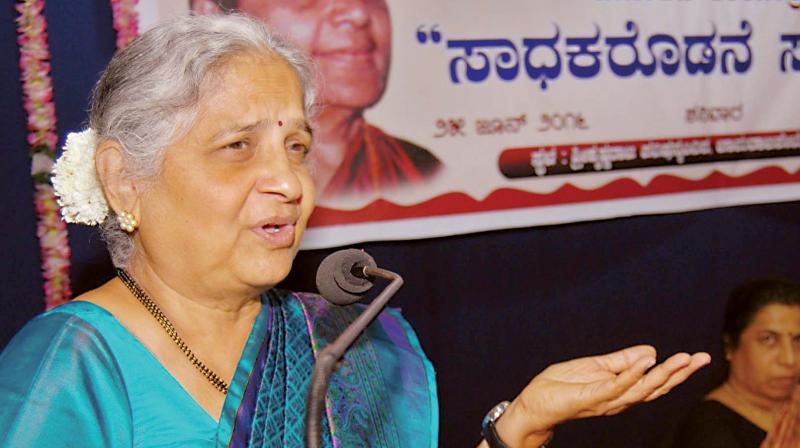Devadasi's plight and other life stories
Philanthropist and author Sudha Murty has always written books that have a social message.

The Devadasi tradition's origin can be traced back to the seventh century in India, during the reign of the Cholas, Chelas and the Pandyas. They were women who lived in temples and were married to the gods. They were well versed in dance and music and held in high regard. Cut to the 21st century, they became nothing more than prostitutes. In walked Sudha Murty into one such district in Karnataka 20 years ago with an aim to eradicate this evil. She rescued 3,000 of these devadasis.
Philanthropist and author Sudha Murty has always written books that have a social message. From having chappals and tomatoes thrown at her and almost giving up her work because of despair, Mrs Murty gets candid in her latest book ‘Three Thousand Stitches’ as she traces her journey with the Infosys Foundation through 11 true short stories.
This book is quite different than your previous books.
Yes, it is. These are the real life stories that I have experienced from the initial years of my work with the Infosys Foundation. The first story is called Three Thousand Stitches and it also adorns the cover, it is the story of the devadasis that I came across. The rest are my experiences with various other things.
As a collective, what are the various things you have spoken about in ‘Three Thousand Stitches’?
Once you read it, you’ll know (laughs). It encompasses the different times of my life. Some directly related, some not. You’ll read short stories about Indian cinema, alcoholism, there are pieces about the evolution of food, how what we eat isn’t Indian at all; experiences of a doctor in a village. There are early bits about my engineering college days where only boys went and I had to go without a toilet for four years! From prostitution to the glitz of Bollywood, the different eras, different sets of time came together. It was my work, it brought the two ends together. Giving me the opportunity to meet so many people, teaching me to take it as it is, a day at a time.
Why is it called Three Thousand Stitches?
The first story is that of the 3000 former devadasis of Raichur. Their life, their struggles and our interventions for 20 years and its results. They gifted me a bedsheet, as seen on the cover that has three thousand little stitches, one from each one of them. They told me that it would keep me warm in winter and cool during the summer. The book starts with it, hence....
Why write this book now?
You know, I’m an emotional writer. Once the experiences become full, I have to let them out. I write. The lives of the devadasis are hard, working with them was harder, and I’ve been doing it for two long decades. Looking back, I felt the need to let the stories spill over.
Being an instinctive, emotional writer, how long did it take for you to write this book?
It took me about 20 days to write (chuckles). I think I started in January. But it is the idea that takes me really long to shape. For example, my Bollywood story, story of its journey has been in my mind for the last 30-40 years. Scratch that, 50 years. It is set right in my mind. I’m an engineer so that helps me write better (laughs). I treat it like a project, accurate and I don’t change my concept at all. It has never happened to me in 27 years.
You’ve written 22 books so far. All of them have done well. What keeps you going?
I never write because I have to. I don’t write it to make money or name. I write it because I love it. I love to write, it is the exhibition of my emotions. Out of all my joys, writing is the highest one.
You wrote in Kannada too. How did you make a transition to English?
Kannada is the language I dream in. I breathe Kannada. It was easy for me to express my emotions at the time in the language coming from a vernacular medium. Then comes George (TJS George) one day telling me to write a column for his newspaper. How could I? I was so hesitant. But then he told me that language was a vehicle. I was asked to write a thousand words and I remember I physically counted them.
(The author has dedicated Three Thousand Stitches to journalist and author T. J.S George thanking him for his contributions to her writing career in English. This is also the only book of hers with a foreword at Mr. George has written.)

